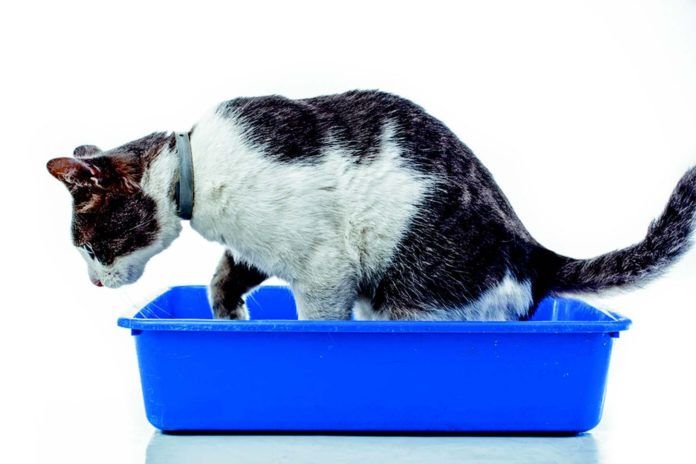When a cat will not relieve herself in her litter box, it’s either for a medical or a behavioral reason.
With that in mind, the first thing you should do when your cat will not void where she is supposed to is take her to the veterinarian to rule out any medical issues. That might include anything from a urinary tract infection to arthritis that makes it difficult for her to climb in and out of the box. When the issue is tended to successfully, the problem of the cat not doing her business in her litter box should go away.
If the issue is not medical but behavioral, it falls into one of two categories: urine marking or litter box aversion. This month, we will focus on litter box aversion, one of the easiest problems to solve if a cat refuses to “go to the bathroom” where she is supposed to.
What litter box aversion looks like
If a cat has litter box aversion, it often means she will not eliminate in the box at all. There generally is no “sometimes in, sometimes out.” The good news: once you figure out the cause, the solution is entirely in your hands. It’s not a matter of retraining your pet but simply getting the litter box “right.” To determine why your cat is averse to using the litter box, you need to ask yourself the following 11 questions. The answers will tell you exactly what you need to do to fix the problem.
1| How many litter boxes do you have in the house? The answer should be one more than the number of cats you have. Cats like a clean space — and some elbow room as they “get to work.”
2|Where are the litter boxes located? We get it; you don’t want to have to be looking at the litter box(es) all day. But they still have to be convenient for cats to reach — and in plain sight. Three right next to each other in a far corner of the basement is not going to cut it.
3| What type of litter do you buy? Most cats prefer unscented, scoopable, finely grained litter — not litter made of small, rock-like particles. And the flowery or perfumed scents people tend to like, cats find uninteresting, or even repulsive.
4| What’s the depth of the litter? Each litter box should contain litter that’s a minimum of two to four inches deep. Cats do not like to do their business in litter that’s any shallower.
5| How often do you scoop and change the litter box? “It’s stressful for a cat to have a disgusting bathroom,” says Tufts animal behaviorist Stephanie Borns-Weil, DVM. She recommends daily scooping, periodic topping off the box with new litter, and changing the litter a minimum of twice a month.
6| How do you clean the litter box? After dumping the old litter, scraping off any stubborn litter with the scooper, and running the box under warm to hot water, you should not apply any scented chemicals, including dishwashing liquid, Pine Sol, or Clorox. What smells good to you is not your cat’s thing.
7| How big is the litter box? This is important if your cat is large because there simply is no litter box big enough for a large cat, says Dr. Borns-Weil. It should be, at a minimum, one and a half cat lengths long and one cat length wide.. For a very large cat, you need a different type of container, she comments, something like an under-the-bed storage box.
8| Does the litter box have a hood? Some cats prefer them; some don’t. (If you have a multi-cat household, you may have to have both kinds depending on your pets’ varying preferences.) A problem with covered boxes is the “out of sight, out of mind” effect on the owner. If your cat prefers a hooded box, don’t forget to check under the hood regularly to make sure the box is clean.
9| Do you keep a liner inside the box? A lot of cats don’t like the texture; be on the lookout for that.
10| Do you keep a plastic underlay beneath the box? Most cats don’t like it. It’s not what they want under them.
11| Is the litter box too deep for the cat to access easily? Some cats do not want to step up to get inside. Also, top-entry boxes with very tall sides do not allow a cat to look before she leaps, and if the landing is dirty, she may not want to try again.
Once you tend to these 11 questions — and get them answered correctly — your cat’s aversion to her litter box should become a thing of the past.
Next month: How to address urine marking that keeps your cat from using her litter box as she should.





Charlie is a stray that took up here. He will not use the litter box period and goes in the house, garage, yard. It was suggested to put dirt in the mix. I saw dig marks but no production. Charlie has even gone right next to the litter box but not in it. He isn’t allowed in the house any more until he gets that he’s supposed to use the litter boxes. Have two in the garage, two in the house and two in the basement… where my housecat prefers to use. Two cats, six boxes .. Older, larger boxes, not the tiny things they sell now-a-days.
Mitzie, our two year old cat, was recently diagnosed with an auto-immune condition. She is being treated with Prednisone (compounded into gel) but recently she refuses to use the litter box to defacate. She does use it to urinate, however. We have had Mitzie for two years along with another cat, Mitt. They have been happy with each other since they were two pounds in weight and have three litter boxes. Since her diagnosis, however, we have made a “:cave” for her in our closet with a new litter box. Since getting it, she refuses to use it other than to urinate. Her “poop” is near the box, but not in it. Since her diagnosis, she has been hiding under the beds, or in the closet and is defacating near, but not IN the box. Can you suggest a solution??
This has been as described above for about a week. Your suggestions would be greatly appreciated. Thank you!! Eunice Shatz and Katherine Gabel
Hi,
We adopted a very skittish Bengal cat female from a local fostering/placement group. Once she was out if the carrier, the cat (named Spirit) hid for 2.5 wks, only venturing out at night to explore.
Initially she would urinate in the litter box and defecate next to it (like over the edge).
Now she won’t go near the boxes, only pooping and peeing on the living room carpet. We have followed all the tips for boxes, litters, placement.
She has been checked out at the vet, and is healthy. She does only poop every other day, so is prob constipated… The very suggested tiny dose of miralax, which we are doing (but are also nervous that we’ll create worse messes to cleanup).
Spirit seems to have a litter box aversion at this point. She is a sweet cat and we want to keep her, but don’t know what to do. We don’t have a carpet-free area to enclose her, unless we get an indoor enclosure (catio)?
If anyone knows if a cat behavioral specialist, we would love to talk to them. Even remote consulting would help.
Thank you, Helen